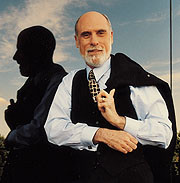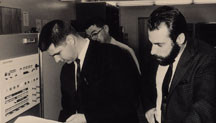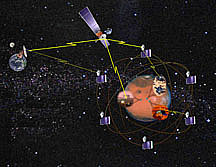
 r Vinton Cerf was the co-designer of the TCP/IP protocol, the computer language that gave birth to the Internet in the mid-70s. This breakthrough subsequently led to work on experiments with packet voice and packet video. r Vinton Cerf was the co-designer of the TCP/IP protocol, the computer language that gave birth to the Internet in the mid-70s. This breakthrough subsequently led to work on experiments with packet voice and packet video.
Since then, he has continued research into developing other Internet-related technology through his key roles in the Corporation for National Research Initiatives and MCI WorldCom. Cerf has also worked tirelessly to make the Internet accessible to more people by forming the Internet Society, an international organisation for global cooperation and coordination of the Internet.
In 1997, he and fellow researcher Dr Robert (Bob) Kahn were presented with the US National Medal of Technology by President Bill Clinton, in acknowledgement of their efforts in founding and developing the Internet.
Besides his role as senior vice-president of Internet Architecture and Technology at MCI WorldCom, Cerf is a highly sought-after speaker, an accomplished writer and budding actor, having made several guest appearances on his favourite TV series, Earth: The Final Conflict.
In his latest project, the Internet visionary is involved in the design and architecture of an Interplanetary Internet, redeveloping protocols for future communications with Mars and even beyond.
INNOVATION was able to catch up with this Internet pioneer in the midst of his hectic schedule to talk to him about the progress of his brainchild.
I: Did you ever imagine that the Internet would achieve such a level of success?
Cerf: The realisation that the Internet would become a major new communications infrastructure came slowly. It was clear from the outset that packet switching (see signpost) was the right concept for computer communication.
In 1986, several companies were formed to build gateways (these were called "routers" then) and it was obvious that there was a business in the sale of such equipment to allow anyone to build pieces of the Internet. By 1988, it became apparent to me that the Internet could not expand much beyond its government-funded boundaries unless it could be used for commercial purposes, forming an economic engine that would pay for Internet expansion. I was a strong proponent of Internet commercialisation, although many in the academic community resisted this idea.
A year later, the first commercial Internet services were under way — UUNET was first, then PSINET, and others soon followed. In retrospect, the Internet began to "take off" in 1988 with annual growth on the order of 100 percent. This rate has continued to this day.
Coincidentally, the World Wide Web originated in 1989 with work by Tim Berners-Lee at CERN in Switzerland. Its commercial debut, by way of Netscape Communications in 1994, has fuelled a massive explosion of new applications, carrying the Internet into the 21st Century.
Right now there are 200 million people using the Internet, which is fairly small considering the world's population of 6 billion. Still, at the rate the Internet access is growing, there should be around 1 billion devices on the Internet by 2007. A good deal of these could be through items such as mobile phones, personal digital assistants and even appliances, as opposed to the more traditional PCs and laptops.
 Dr Vinton Cerf (Picture on right: Dr Cerf (far right) in 1970 with a colleague at UCLA over the SIGMA 7 computer, the first host to be connected to the ARPANET, and used to measure its performance) Dr Vinton Cerf (Picture on right: Dr Cerf (far right) in 1970 with a colleague at UCLA over the SIGMA 7 computer, the first host to be connected to the ARPANET, and used to measure its performance)
I: What brings you the most satisfaction about the way the Internet has progressed? What is a source of concern?
Cerf: The Internet connects us in ways we've never been connected before and therein lies its power, appeal and indeed its risk. The greatest satisfaction for me has been to see the enormous outpouring of creativity and resources from around the world to further develop the Internet, its technology and its applications.
It can also bring together people holding common interests on a global scale, and allow the capture and preservation of the cultural richness of the world's ethnic diversity. It will surely open new opportunities for education, in particular by increasing the literacy rate around the world.
Other benefits would come with the increase in research materials, and the pursuit of personal interests. We should also encourage entrepreneurial thinking in the academic world.
The greatest concerns are that the Internet might not be able to sustain its enormous growth rate, and that its social and economic effects may not be well enough understood. Also, there is the concern that children may have access to "adult" material, a situation that I hope will be remedied as more tools are available to limit this exposure.
To be sure, we have much to learn about this new information infrastructure, and it will be a voyage of discovery not unlike the exploration of the New World in the 16th Century.
I: When you picture the world in 2010, what changes do you see — specifically in our use of the Internet?
Cerf: I expect to see a high degree of penetration of Internet services everywhere — not the least of which will be in Internet-enabled appliances. Telephony, television, radios and all forms of "print" material will be distributed through Internet. Mobile access to Internet will be provided through advanced cellular radios. Homes will be fully "wired" and appliances managed and controlled through this medium. For example, a washing-machine user may browse a website to find out how a very bad stain on a piece of clothing can be removed. He may then have the appropriate instructions conveyed to this washing machine through the Internet. Cars will also be fully enabled, delivering performance details for maintenance purposes through the Internet. The Internet will have grown to exceed the size of the telephone network and will likely have become the telephone network, in effect. Information will have become a first class "object" in Internet space. The business world will be richly interconnected and the exchange of information will have enabled mass customisation, such as improvements in time inventory management, 24-hour-per-day operations and financial transactions. There may be a time when intelligent agents will roam the Web automatically performing tasks: an auto insurance policy being automatically executed when a car is purchased over the Internet. Or a program could be written to monitor the financial wire to watch interest rates and tell a bank customer when it might be a good idea to refinance his home. What I am working on right now is also a great source of enthusiasm. The project is with the US National Aeronautics and Space Administration's Jet Propulsion Laboratory developing Interplanetary Internet. It will be an extension of the Internet as we know it today, bringing the connection to Mars and even beyond. It is hoped that a manned mission to Mars will use this technology by 2030.
I: What impact will the Internet have on teaching and learning in particular?
Cerf: Internet will almost surely offer new avenues for teaching and learning. The notion of lifelong learning will take on new meaning, as Internet becomes more and more available, accessible and affordable around the world. The most striking aspect of Internet evolution will be the housing of the world's knowledge within its framework. Any information that is required will be culled from the Internet. Unlike the print media of the past, digital information can be searched, sorted, analysed and composed with the help of software and computers. By linking millions, if not billions of information resources together, the Internet becomes a treasure house in which the addition of a single datum adds more than a linear amount of value, as it interacts with all the other data contained in the system.
I: There is much discussion about security on the Internet, especially in the area of e-commerce. What do you think are the possible solutions?
Cerf: The best technological approach seems to be based on public key technology (see Signpost) and the development of a public key infrastructure to support authentication and confidentiality. We have some distance to go before such an infrastructure can be widely realised. Apart from technology, there are open questions regarding the liability of certificate issuing authorities, uniformity of personal identification used to obtain certificates and a variety of other non-technical issues. It seems likely that national and international agreements might be needed to provide a framework for such an infrastructure to flourish.
The History of Vinton Cerf and His Net |
| 1967-72 |
Graduate student at University of Southern California, Los Angeles. Worked at the legendary Professor Len Kleinrock's laboratory, helping to develop host level protocols of the ARPANET (a government-supported data network that would use the technology which by then had come to be known as packet switching)
|
| 1972 |
Moved to Stanford as part of electrical engineering and computer science faculties |
| 1973 |
With Bob Kahn, developed the concepts underlying the Internet and presented a preliminary paper in September of that year to the International Network Working Group |
| 1974 |
In October, led group in a seminar focusing on the detailed development of protocol concepts; late in the year, first full draft of Transmission Control Protocol (TCP) achieved |
| 1975 |
Continued to lead efforts into developing test implementations into TCP at Stanford, London's University College, and Bolt Beranek and Newman |
| 1976 |
Managed packet technology and internetting research programs at the Advanced Research Projects Agency (ARPA) |
| 1977-78 |
Took first steps to deploy Internet on a wider scale, together with colleagues at ARPA |
| 1979—mid-80s |
Led intense development, including:
- Basic TCP design leading to three-way handshake for establishment of initial sequence numbering at each end of the TCP connection
- Separation of Internet Protocol (IP) from TCP to permit applications that did not need the reliability and sequencing of the latter. Resulted in the TCP/IP protocol suite. By year-end, all hosts on the ARPA- sponsored networks were running TCP/IP
|
| Late 1982 |
Joined MCI WorldCom to lead engineering of MCI Mail
|
The Gateway to Mars and Beyond

Interplanetary Internet is conceived by the National Aeronautics and Space Administration (NASA) as an extension of the Internet that will serve as a communications conduit for future missions to Mars and beyond.
The architecture under examination for enabling these capabilities consists of a constellation of microsatellites (Microsats) and one or more relatively large Mars Aerostationary Relay Satellites (MARSats).
The Microsats would serve both as communication relays between Mars exploration elements (landers, rovers, balloons, airplanes and others) and the Earth, and as navigational aids for the exploration elements.
MARSats, on the other hand, would be much like the very high-bandwidth geostationary communications satellites in Earth's orbit. These satellites orbit the Earth, along its equatorial plane at the same rate as the Earth rotates. In so doing, they are always positioned over the same region on the Earth. In the case of MARSat, however, the satellite would orbit Mars in this fashion, not the Earth.
In both the case of the Microsats and the MARSats, communication with the Mars exploration elements would occur using an Internet protocol similar to what enables communications via Earth's Internet.
Deployment of a prototype Microsat, tentatively scheduled for 2003, would be the first step in creating this Mars "Internet". A series of probes will gradually envelope the planet between now and 2040.
Mars will probably be the first of many gateways on the Interplanetary Internet — an Internet that would enable virtual presence throughout the solar system.
According to NASA, the study material in the Mars Network website described above is one possible approach to increasing data rates, connectivity and navigation capability on Mars. As NASA's plan for Mars exploration progresses, its associated approach to communication and navigation may evolve as well.
Source - Jet Propulsion Laboratory, National Aeronautics and Space Administration.
For further information, please see: https://marsnet.jpl.nasa.gov
|
I: What are some of the up-and-coming technologies that will have an effect on the Internet?
Cerf: In the near term, ways of providing differentiable services will be important — examples include multi-protocol label switching (MPLS) and policy-based routing (see signpost). In the longer term, concepts such as Sun Microsystems' Jini (see Signpost) and similar ideas will populate the Internet with tireless and distributed software processes working for our benefit 24 hours a day. They will be feeding on networked information in the same way that fractional horsepower electric motors do work for us, while feeding on energy from the electric power grids. Public key cryptography will play a critical role in electronic commerce and in the securing of personal privacy. New network access technologies including digital subscriber loops, cable modems, packet radio links and optical fibres will enhance and extend broadband Internet services. Miniaturisation of Internet-capable chips will allow all manner of devices to become a part of the Internet.
I: What do you think is the biggest threat to the Internet?
Cerf: Apart from the vast challenge of scaling to meet the demand of six billion potential users, Internet may be harnessed for unsavoury purposes. Fraud, surveillance and invasion of privacy are all threats. Our increasing dependence on the Internet places enormous responsibility on Internet service providers and equipment/software developers to make the Internet as robust as it can possibly be. Moreover, it will be vital to establish legal frameworks in support of electronic commerce and to establish jurisdictional and tax practices that are compatible with worldwide operation of the network. Perhaps, in the end, the biggest threat is that our enormous dependence on the Internet will be its undoing, if we cannot evolve the technological, social, economic and legal practices to cope with the intimacy and interdependence of globalisation. Reading E M Forster's The Machine Stops is as good a warning as any we might ever get, that we must approach the evolution and use of Internet with considerable thought and care. The point of the book is overdependence on technology that isn't sufficiently robust to justify this dependence. In summary, we have to make sure we match up our dependencies and our ability to produce highly resilient and reliable computer and communications systems.
|
Signpost
Packet switching: Refers to protocols in which messages are broken up into small packets before they are sent. Each packet is transmitted individually across the Internet, and may even follow different routes to the destination. Each packet has a header information about the source, destination, packet numbering, etc. At the destination the packets are reassembled into the original message.
Public key technology: The keys are used to encrypt or decrypt the messages electronically. Public keys only work one way. You can put something in the safe and lock it, but you need the other key of a "public key pair" to unlock it again. It doesn't matter which key is used; either one will lock the box while the other has to be used to unlock it.
Multi-protocol Label Switching: This is the Internet's way of doing what ATM systems have been doing for a while — virtual circuit setup. A "label-switched-path" is a virtual circuit through a store and forward network. The label switching refers to the fact that a frame or packet has a label saying where it goes on its next hop when it gets there; the packet or frame is prefixed with the next hop label.
Policy-based routing: This has to do with the process of deciding whether a given frame, or packet can be accepted into the transmission system for transport. The policy server says whether the originator has the authority to issue a packet requesting any particular quality of service and whether the system can accept another packet for that customer.
Sun Microsystems' Jini: This connection technology enables spontaneous networking of a wide variety of hardware, software and services.
|
|



 r Vinton Cerf was the co-designer of the TCP/IP protocol, the computer language that gave birth to the Internet in the mid-70s. This breakthrough subsequently led to work on experiments with packet voice and packet video.
r Vinton Cerf was the co-designer of the TCP/IP protocol, the computer language that gave birth to the Internet in the mid-70s. This breakthrough subsequently led to work on experiments with packet voice and packet video.
 Dr Vinton Cerf (Picture on right: Dr Cerf (far right) in 1970 with a colleague at UCLA over the SIGMA 7 computer, the first host to be connected to the ARPANET, and used to measure its performance)
Dr Vinton Cerf (Picture on right: Dr Cerf (far right) in 1970 with a colleague at UCLA over the SIGMA 7 computer, the first host to be connected to the ARPANET, and used to measure its performance)
